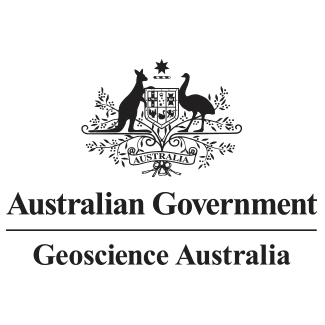Full description
The Murray Basin is a saucer-shaped basin with flat-lying Cenozoic sediments up to approximately 600 m thickness (Brown and Stephenson, 1991). Constraints on the thickness of the Murray Basin have been compiled from: drillholes, reflection seismic profile interpretations, refraction seismic profiles and depth to magnetic basement estimates (Target_type.pdf). Target depths were sourced from Geoscience Australia, the national Groundwater Information System database (Http://www.bom.gov.au/water/groundwater/ngis/), the Geological Survey of Victoria (http://earthresources.vic.gov.au/earth-resources/geology-of-victoria/geological-survey-of-victoria) and the Geological Survey of South Australia (http://www.minerals.statedevelopment.sa.gov.au/geoscience/geological_survey). In addition, some of the magnetic depth estimates used data from McLean (2010). To constrain the thickness of Cenozoic cover where sediments were either absent or very thin we generated shallow-depth values in areas with post-Cenozoic geology and high topographic relief. In all, 5436 depth estimates were compiled (Target_depths.xlsx). The input datasets have been used to generate two predictive models of the thickness of Cenozoic sediments within the Murray Basin. The first model uses kriging of the depth estimates to generate a gridded surface using a local-area linear variogram model as a means of interpolating between constraints (Murray_Basin_kriging_Cenozoic_thickness.pdf; Murray_Basin_krig.tif -floating value grid). The second model uses a machine-learning approach where correlations between 17 supplementary datasets and 5436 depth estimates are used to derive a predictive model. We used a supervised learning algorithm known as Gaussian Process (GP) to generate the integrated predictive model. Gaussian Process is a non-parametric probabilistic approach to learning. It uses kernel functions to measure the similarity between points and predict values not seen from the training data (see Read_Me_GP.rtf). The supplementary datasets used in the model are listed in Table 1 and model variable settings can be found in read_me.rtf (Murray_Basin_GP_Cenozoic_thickness.pdf; Murray_Basin_GP_model.tif -floating value grid). Both approaches delineate the overall structure, geometry and thickness of the Murray Basin. The advantage of the machine learning approach is that it learns relationships between the depth and supplementary datasets which allow predictions in areas with limited constraints.References
Brown, C. M. and Stephenson, A. E., 1991, Geology of the Murray Basin, southeastern Australia, Canberra, Bureau of Mineral Resources Bulletin 235, 430 p.
McLean, M.A., 2010. Depth to Palaeozoic basement of the Gold Undercover region from borehole and magnetic data. GeoScience Victoria Gold Undercover Report 21. Department of Primary Industries, Victoria.
Table 1. Supplementary input datasets used in predictive estimation of Murray Basin thickness, utilising a machine learning method
Covariates* Description
1 Latitude Gridded latitude values
2 Longitude Gridded longitude values
3 Elevation Terrain elevation – 90m shuttle DEM
4 Distance from bedrock Euclidean distance from outcrop geology units older than Cenozoic
5 Gravity Terrain and isostatic corrected Bouguer gravity
6 Gravity 1228 Upward continued gravity at 1228 metres
7 Gravity 2407 Upward continued gravity at 2407 metres
8 Gravity 6605 Upward continued gravity at 6605 metres
9 Gravity 18124 Upward continued gravity at 18124 metres
10 Gravity 35524 Upward continued gravity at 35524 metres
11 Gravity 49734 Upward continued gravity at 49734 metres
12 Gravity 97479 Upward continued gravity at 97479 metres
13 Gravity – 1k Isostatically corrected gravity subtracted from upward continued gravity at 1000 metres
14 Magnetics 5km Upward continued magnetic anomaly grid at 5 km
15 Magnetic 10km Upward continued magnetic anomaly grid at 10 km
16 Magnetic 5-10km Upward continued 5km magnetic anomaly grid subtracted from upward continued 10 km magnetic anomaly grid
17 Magnetic basement Depth to magnetic basement using the tilt method.
*Primary datasets including gravity, magnetics and surface geology sourced from Geoscience Australia http://www.ga.gov.au/data-pubs/maps
Elevation dataset used the 3 second (~90m) Shuttle Radar Topography Mission (SRTM) digital elevation model. https://pid.geoscience.gov.au/dataset/ga/72760.
Lineage
Maintenance and Update Frequency: asNeededCreated: 29 06 2017
Issued: 10 07 2017
Data time period: 2017
text: westlimit=138.181; southlimit=-37.922; eastlimit=148.875; northlimit=-29.798
User Contributed Tags
Login to tag this record with meaningful keywords to make it easier to discover
Dataset descriptions (pdf)
uri :
https://d28rz98at9flks.cloudfront.net/111564/111564_dataset_descriptions.pdf![]()
How to generate the predictive model (pdf)
uri :
https://d28rz98at9flks.cloudfront.net/111564/111564_how_to_generate_GP.pdf![]()
Target locations and Depths (xlsx)
uri :
https://d28rz98at9flks.cloudfront.net/111564/111564_target_depths.xlsx![]()
Map showing kriging Cenozoic thickness (pdf)
uri :
https://d28rz98at9flks.cloudfront.net/111564/111564_kriging_cenozoic_thickness.pdf![]()
Map showing GP Cenozoic thickness (pdf)
uri :
https://d28rz98at9flks.cloudfront.net/111564/111564_GP_cenozoic_thickness.pdf![]()
Murray Basin GP model (floating value geotiff)
uri :
https://d28rz98at9flks.cloudfront.net/111564/111564_GP_model.zip![]()
Murray Basin krig (floating value geotiff)
uri :
https://d28rz98at9flks.cloudfront.net/111564/111564_krig.zip![]()
Target depth type (pdf)
uri :
https://d28rz98at9flks.cloudfront.net/111564/111564_target_type.pdf![]()
- Local : pid.geoscience.gov.au/dataset/ga/111564
- global : 07938726-319d-42e3-9af8-d3f2229701de


